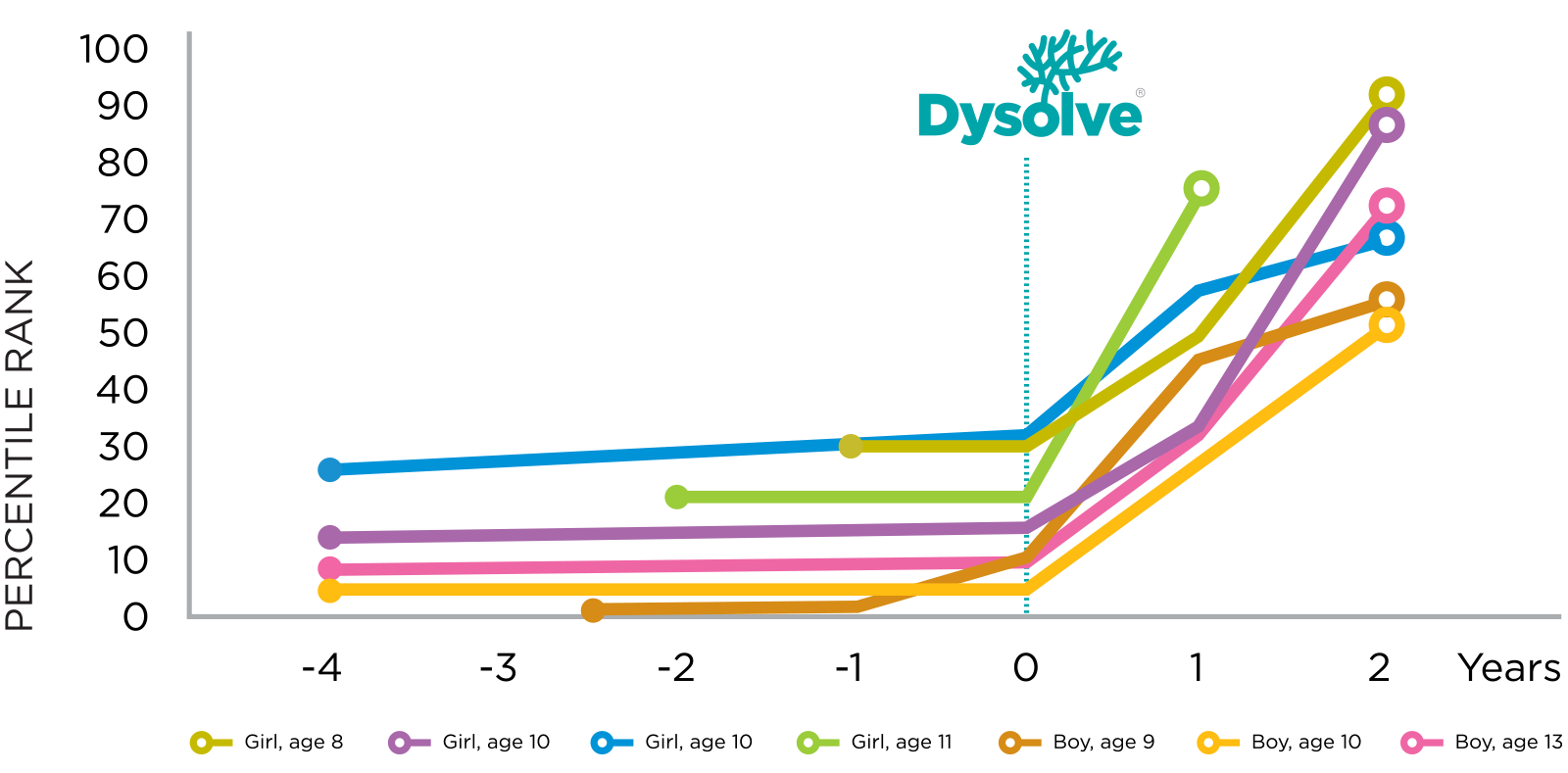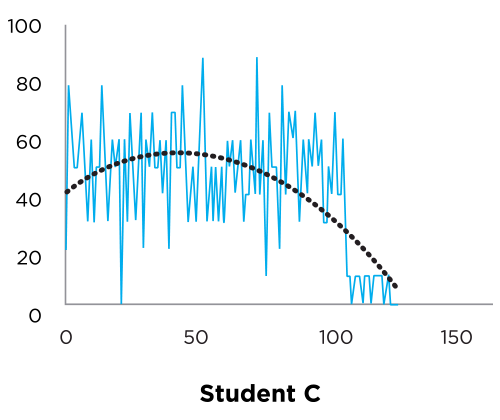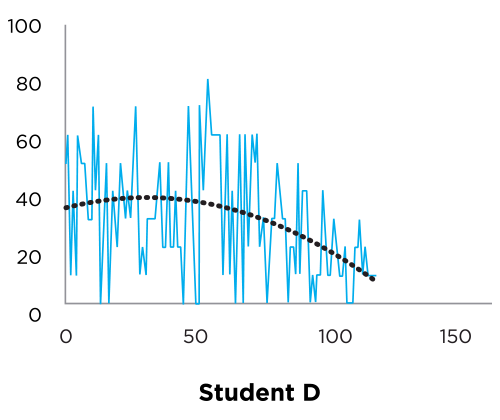
The only program that corrects
learning disabilities
Many learning issues involve problems processing language. We have over 30 years of expertise in the following areas:
DYSLEXIA
DYSCALCULIA
ANXIETY
ADHD
Reading disability, writing disability (dysgraphia) and language disorders are due to processing difficulties
Instruction in English
Difficulty understanding math instruction can lead to math disability
All ages - Kindergarten and up
Processing overload can lead to behavioral issues and physical symptoms
Our experts understand the connection
Learn the triggers for restlessness and distractibility and their solution
We know why ADHD co-occurs with other conditions
Learning disabilities or disorders include
dyslexia, dyscalculia and dysgraphia
Learning ISSUES
Dyslexia
Dyslexia is a reading disability or difficulty. Those affected have problems processing language. It is the most common learning disability affecting 20% of the population.
Dyscalculia
Dyscalculia is a math disability that often co-occurs with dyslexia. Dyslexia results from language-processing difficulties. These difficulties can prevent students from acquiring foundational math skills and facts in the primary grades, making math learning harder in later years. Dyscalculia affects about 10% of the population.
Dysgraphia
Dysgraphia is also caused by language-processing difficulties, which impede the learning of spelling, written vocabulary and composing skills. By “dysgraphia,” we mean the above, not difficulty with the physical act of handwriting. People who cannot read (dyslexia) often also cannot write (dysgraphia).
We have one of the most detailed databases on dyslexia and learning disabilities due to Dysolve® analytics and our own fieldwork of 3 decades.
Learn more about Dyslexia and Learning Disabilities
LEARNING DISABILITIES
What is a learning disability?
Learning disabilities (LD) include dyslexia (reading), dyscalculia (math) and dysgraphia (writing), among others. Dysolve® focuses on these three specific learning disabilities. LD is also called “learning differences” and “learning disorders.”
DYSLEXIA
What is dyslexia, exactly?
Dyslexia is an “unexpected” reading problem. That is, affected individuals should have been able to read, given their intelligence, upbringing, home and school environment, literacy training, motivation, intact vision and hearing. This reading problem leaves parents and teachers puzzled as to why these students can’t learn to read despite great effort.
Dyslexia is merely the effect of a set of deeper underlying problems. These underlying problems affect language processing. Dysolve® treats dyslexia as a language-processing condition. Most, if not all, of the students who come to us for evaluation display such problems.
This is why individuals with dyslexia often show other difficulties such as
Root causes
Individuals with dyslexia typically have one or more of the root causes affecting language processing and cognitive (mental) functioning. We process language when we speak, listen, read, and write. We function cognitively when we understand, remember, and transform ideas and problem-solve. Language processing and/or cognitive functioning is disrupted in the brain for people with dyslexia.
Because the number and type of root causes differ from person to person, dyslexia occurs on a spectrum with wide individual variation.
Brain disruption
Brain studies consistently link reading disability with reduced or absent activity in the left hemisphere (temporoparietal regions) during certain tasks. Typical readers show dominant activation of the left hemisphere to process language rapidly and automatically while reading. In contrast, those with dyslexia tend to hyperactivate the right hemisphere instead. When language input is not processed rapidly and automatically, many daily and academic tasks are affected.
Complexity of reading
To understand a passage such as this one, we need to coordinate many processes at the same time:
We have to perform these processes and others rapidly so that we don’t forget the beginning of a sentence by the time we get to the end.
Automatization of reading
That is why we perform many of these subprocesses of reading automatically. Automatic processing frees up mental resources to enable us to think about what we are reading and respond with new ideas. The complexity of reading explains why many individuals with dyslexia get overwhelmed by the task.
Generally, for each person with dyslexia, one or more underlying root causes may result in a multitude of surface problems. Thus Dysolve® first separates out the causes from the effects. For example, if someone misspells simple words and misarticulates others, which is the effect and which is the cause?
If you or your child is facing such questions, you need an experienced evaluator to analyze the data necessary to answer questions about underlying causes accurately and fully. Only then can you pursue the best available solution to address the problem.
Dysolve® takes this logical approach.
What are common dyslexia symptoms?
Many people with dyslexia find these difficult:
Based on Dysolve’s own fieldwork with this population, we can explain why these symptoms occur:
UNDERSTANDING AND REMEMBERING SPOKEN LANGUAGE — Many people with dyslexia have problems processing speech sounds and thus often face difficulties understanding speech as a result. Consequently, they may not store what was said accurately for later recall.
FLUENT READING — People who cannot process spoken language efficiently find reading demanding because of a host of difficulties. They may have trouble storing and retrieving word forms and spelling, confuse similar-sounding words, overburden their memory when tracking and analyzing sentence structure and meaning.
RECOGNIZING SMALL, COMMON WORDS — Small function words such as the, in and on are not prominent acoustically in speech and may be missed by people who have processing problems, especially since speech is uttered at a fast rate.
RECALLING FAMILIAR WORDS — Familiar words such as function words may be missed for the reason given above. Also, people who have trouble processing spoken language may store words in less efficient ways that are not sound-based. As a result, they may take longer to retrieve words or fail to do so successfully.
SPELLING SIMPLE WORDS — People with dyslexia may not be fully aware of the sounds that make up the words they use and thus have trouble translating sounds to letters in spelling. Speaking does not require conscious knowledge of the sounds of words, but spelling does.
There are many more symptoms that Dysolve® researchers have documented, many of which have gone unnoticed by others. These signs of dyslexia often surface when affected individuals perform Dysolve’s targeted yet comprehensive tests.
Beyond common symptoms of dyslexia, Dysolve® tests probe deeper for root problems specific to each individual. Dysolve® is designed to locate and correct each root problem found.
Attention issues
ADHD
ADHD often co-occurs with dyslexia and is characterized by inattention, hyperactivity and impulsivity. As our concern is with learning, we focus on inattention and hyperactivity leading to distractibility in ADHD. ADHD affects 11% of the population.
Learn more about ADHD
ADHD
What is ADHD?
ADHD is one of the most common brain conditions to affect children (neurodevelopmental disorder). It may last into adulthood. It is characterized by inattention, hyperactivity, and/or impulsivity. Different children display different symptoms to varying degrees.
Researchers face a lot of unanswered questions about ADHD. We provide below what we have learned from our 30 years of fieldwork with this population.
What causes ADHD?
Researchers do not yet have an answer. However, we know in Dysolve® what can trigger ADHD symptoms in each child.
Will my child’s ADHD go away? What treatments are available?
ADHD may last into adulthood. Medical treatments for even young children often involve drugs. These drugs may affect growth, appetite, or sleep. Non-invasive treatments include behavior therapies to manage parents’ behavior towards the child or to manage the child’s behavior.
When Dysolve® clears processing problems, students’ ADHD symptoms often dissipate as well. ADHD symptoms dissipate at about the same time that school grades improve.
How do I know whether my child has ADHD or autism?
ADHD and autism often co-occur, and many affected children are misdiagnosed or undiagnosed. Like ADHD, there is no test for autism currently. Among other symptoms, children with autism may struggle with verbal expression, communication and social interaction.
At Dysolve®, students’ ADHD symptoms unfold in characteristic patterns that are distinct from those of autism. Case-specific information is shared with affected families.
Why can’t my child focus?
Understanding instructions, retaining information, doing schoolwork or chores—they all involve brain processes. When some brain processes do not run efficiently, doing tasks becomes challenging. Some children may resort to what we call “disattention”—blocking further input as the brain gets overwhelmed. Dysolve® identifies the specific processes affected so as to get to the root of this focusing problem.
Why can’t my child sit still?
When the brain gets overwhelmed, some children (and even adults) display this processing overload physically, such as by moving around. Some students ask to go to the restroom a lot at school for this reason. You can help your child understand the behavior, while Dysolve® works on reducing this processing overload.
Autism
Autism is characterized by difficulties with speech, communication and social interaction. Autism spectrum disorders affect about 2% of the population.
We have one of the most detailed databases on ADHD and autism due to Dysolve® analytics and our own fieldwork of 3 decades.
Processing issues
Auditory Processing
Auditory processing usually involves the reception of speech sounds. Problems with auditory processing are common in those with dyslexia and other language disorders. They can impede speech, listening comprehension, reading and writing. They can also affect aspects of learning such as attention and memory.
Processing Speed
Processing speed issues are often found in those with language and learning difficulties. Verbal input has to be processed rapidly and often automatically for many academic tasks. Our tests can determine when students fall below processing speed thresholds for specific tasks.
We have one of the most detailed databases on ADHD and autism due to Dysolve® analytics and our own fieldwork of 3 decades.
OTHER issues
Speech and Language Impairment
Speech articulation, stuttering and other production issues are common language difficulties. Students with learning disabilities may also exhibit other forms of language impairment that do not fall into labeled categories.
Memory and Other Cognitive Issues
Problems processing language may impact students cognitively. They may show difficulty remembering instructions, retaining information, retrieving words, and so forth.
Anxiety Issues
Students experiencing difficulty processing language may exhibit symptoms of anxiety. Their processing difficulty may cause them to feel overwhelmed by the task (cognitive overload.)
Questions? Ask our experts
Teachers are not trained to correct dyslexia and learning disabilities. Even reading teachers and dyslexia specialists in the US do not correct these conditions; they help students learn to cope with these conditions for the rest of their lives. Dysolve® is the only program that has successfully corrected these conditions.
Children do not outgrow reading problems. Dyslexia is different from a developmental lag in reading (delayed reading). With dyslexia, postponing intervention may make it even harder for your child to catch up. Students in primary grades learn about 3,000 new words a year, increasing to about 10,000.
Reading and learning problems often harm self-esteem, social relationships, motivation and attitude towards school. The longer we wait to act, the larger and more challenging the problem becomes.

Teachers are not trained to correct dyslexia and learning disabilities. Even reading teachers and dyslexia specialists in the US do not correct these conditions; they help students learn to cope with these conditions for the rest of their lives. Dysolve® is the only program that has successfully corrected these conditions.
Children do not outgrow reading problems. Dyslexia is different from a developmental lag in reading (delayed reading). With dyslexia, postponing intervention may make it even harder for your child to catch up. Students in primary grades learn about 3,000 new words a year, increasing to about 10,000.
Reading and learning problems often harm self-esteem, social relationships, motivation and attitude towards school. The longer we wait to act, the larger and more challenging the problem becomes.
Students at our Dysolve Center receive these:

Dysolve® is a computer expert system for dyslexia and learning disabilities. EduNational developed Dysolve® in New York and fieldtested it extensively before launching it in the US in 2017. EduNational’s technology was granted US and international patents.
Evaluation
Dysolve® locates each student’s processing deficits underlying conditions such as dyslexia and learning disabilities. In the first quarter of the program, Dysolve® generates an Evaluation Report specifying a student’s risk levels for key factors impacting language, cognition and learning. Dysolve® continues to evaluate for changes and improvements throughout a student’s program, specifying them in Progress Reports quarterly.
Online training with Dysolve®
Dysolve® - the world’s first AI expert system for evaluating and correcting language-processing difficulties
These difficulties underlie many learning issues
Upon signup, students can engage online with Dysolve® through interactive verbal games at home for about 15 minutes/day, 5 days/week. Dysolve® customizes these games to each student’s difficulties. The games evaluate and correct difficulties.
Games are used to lessen anxiety for struggling learners, yet allow the AI system to collect important performance data.
Dysolve®-guided English instruction and assessment
We also address students’ difficulties through English instruction, in tandem with their online training. We use proprietary teaching materials that have been specially developed by our Company’s experts in the US for this population. Our instruction provides the foundation for English usage. We cover particular topics when a student is most receptive to acquiring them, based on their progress in the online Dysolve® training. Assessment results are provided monthly or quarterly.
Our goal is a fully functioning speaker, listener, reader and writer in English.
Consultation
Each child is assigned to a Dysolve® Certified Teacher. This teacher oversees the child’s case and checks in with the family to facilitate progress. These consultations allow them to review major aspects including the psycho-social, academic, and environmental. The close, nurturing relationship between the teacher and the child and family is important to the student’s success.
Mentoring
Dysolve® graduates often serve as effective mentors of younger students. Older students become role models to demonstrate what is possible with full compliance to our program.
Many of our students also share similar talents and interests. Students with weaknesses in language often have talents in other areas, especially the visual and spatial. Students with a disability and a talent are called “twice-exceptional” (2e). We find opportunities for their talents to shine. Some of our graduates pursue careers in architecture, engineering, design, and computer science.
Dysolve’s goal is to get students from twice-exceptional to singularly exceptional - from 2e to e
Specialist services
Some students may need more than the above basic services. They can register for additional programs to address issues other than dyslexia and dysgraphia, such as math and speech. These programs are administered by specialists. We also assess all students at the Center continually to determine whether they need specialist services.
FAQS
BEFORE DYSOLVE®
How do I know that Dysolve® is right for my child?
Dysolve® deals with basic brain processes that support language, learning and thinking. In 99% of the children we meet, their problems with schoolwork and behavior are due to inefficiencies in these processes. Processing inefficiencies may affect behavior and the body (e.g., meltdowns, headaches). Dysolve® is thus the logical starting point to resolve the problem.
Is my child too young/old for Dysolve®?
No. Dysolve® AI customizes evaluation and intervention specifically for each person. Pre-K children may need adult help with online games.
Which language does Dysolve® use?
Dysolve® is currently only available in English. If your child can speak and understand English, your child can use Dysolve®.
What can you guarantee?
You will know whether your child has dyslexia. You will know why your child has dyslexia and how to get it corrected. The biggest factor for success in Dysolve® is your child’s willingness to follow the program fully.
My child has difficulty reading. Shouldn’t I start with tutoring?
No. Reading involves many brain processes. Problems with any of these processes will affect reading. The logical approach is to correct processing problems first before learning to read. Tutoring on spelling, vocabulary or reading is not effective otherwise. Worse, tutoring at this point can harm your child’s attitude, motivation and sense of self-worth—when your child works hard during tutoring but still continues to fail in school.
How does Dysolve® compare with other providers?
For evaluations:
No other provider has the expertise and technology to get to Dysolve’s level of specificity. Neuropsychological evaluations cost about USD5,000+ in the US and aren’t blueprints for intervention, but Dysolve® evaluations are. Screeners are short tests indicating dyslexia risk but don’t diagnose.
For interventions:
In the US, some dyslexia/reading specialists charge USD10,000 for 6 weeks of instruction. Online programs address some aspects of spelling or reading. With these interventions, students with dyslexia generally stay below reading proficiency throughout school.
In contrast, Dysolve® students reach grade-level proficiency within 1-2 years. 100% of Dysolve® users who complied fully with the program reached this goal.
DURING DYSOLVE®
What can I expect in Dysolve®?
What do I need to set up?
Desktop, laptop or chromebook. Chrome browser. No downloads or installs. Use a wired headset if the room is noisy.
Is there orientation training or a manual I have to read first?
No. Dysolve® is plug and play.
How does Dysolve® work?
Students log into their accounts at dysolve.com and play each game presented. The games feed important information about the user to the AI system. The AI system uses this information to build new game activities.
How soon can I see an improvement?
That depends on the scope and severity of your child’s problem, other co-occurring conditions, and practice. Past students noticed improvements in their schoolwork around 3-6 months, usually in spelling first.
What are your results?
Dysolve® students advanced above the 25-30th percentile (dyslexia threshold) in standardized reading tests to reach the 50th+ in 1-2 years, regardless of age. In the US, after Grade 3, failing readers using other methods stay below the 50th throughout school.
What does my child have to do in Dysolve®?
Log in for at least 15 mins/day, preferably 5 days/wk to play Dysolve® games.
What do I have to do while my child is in Dysolve®?
Ensure that your child is practicing 5 days/wk as recommended. Work out a reward system to keep your child motivated. Your child should practice without your help.
Does the Dysolve® program conflict with my child’s school and other programs?
No. Dysolve® works at a deeper level—on brain processes. Other programs work on skills or content.
Can I cancel anytime?
Yes. Dysolve® is a monthly subscription.
AFTER DYSOLVE®
What comes after Dysolve®?
For dyslexia or language disability, these are the logical steps:
1. Identify processing issues
2. Correct processing issues
3. Intensively correct remaining issues
4. Learn to spell correctly
5. Learn to read fluently
6. Learn to write effectively
Dysolve® focuses on 1-3, and part of 4. After Dysolve®, a student may catch up with reading and writing with the aid of an instructor. But many of our students take steps 5-6 on their own, because learning is no longer an issue after Dysolve®.
For math disability, the student would start with steps 1-3, followed by these:
4. Learn arithmetic operations and basic math facts
5. Increase speed of computation
6. Learn grade-level math
What to Expect
Historically, our students saw improvements at school around 3-6 months, e.g., in spelling.
100%
advanced above the 25th percentile in school standardized reading tests in 1 year.
75%
advanced above the 50th percentile in 2 years.
100%
who completed their Dysolve® programs reached reading proficiency.
50%+
in Grades 5-8 advanced from the bottom 25% to the top 20%
WHO WE ARE

CEO
CORAL P.S. HOH, PhD, is one of the few experts on language processing of exceptional populations across the spectrum. She is a referee for academic journals owing to her pioneering studies. Her research received funding from the National Science Foundation (USA), and she was an editorial board member of a national association. Dr. Coral is the author of books and research articles on Linguistics, language and cognition. She is a co-inventor of patented computing technologies for language disorders.

President
KYOICHI HARUTA, PhD, is a pioneer in hardware and software research with a PhD from MIT. During a 4-decade career, Dr. Haruta worked with Nobel laureates to help usher in a new era of Information Technology and Communications for the US and was named Distinguished Member of Technical Staff at the premier research facility of Bell Labs. He earned patents for cutting-edge software programs for AT & T and Lucent Technologies and gave talks at such institutions as Carnegie Mellon University.

Director
EVAN Y. HARUTA, MS, specializes in problem evaluation of large-scale computing environments and has resolved problems with parallel sysplex systems worldwide for nearly 30 years, earning over 50 Excellence Awards. As a Senior Software Engineer for IBM, he presented regularly at tech conventions for global companies in education, healthcare, finance, energy, transportation, and federal agencies. He is a lead developer of an international software workshop series and a contributing author to a tech magazine.

Advisor
C. RYAN KINLAW, PhD, earned an MEd from Harvard and a PhD in Developmental Psychology from the University of North Carolina at Chapel Hill. He regularly serves as a reviewer for leading peer-reviewed journals and professional organizations such as the American Educational Research Association and the Society for Research in Child Development.

Advisor
WEN-YU CHIANG, PhD, is Professor in the Graduate Institute of Linguistics of National Taiwan University. Dr. Chiang was visiting and guest scholar to Harvard and Kyoto University. Her theoretical and empirical research has been featured in international journals. An expert on Chinese Phonology, Dr. Chiang is the author of several books and recipient of prized literary awards and a national award as Taiwan’s Ten Most Outstanding Young Women.

Advisor
KEVIN GAUGLER, PhD, was the 2010 recipient of the American Council on the Teaching of Foreign Languages prestigious Award for Excellence in Teaching with Technology. His innovative methodologies have been featured in tech and education publications, and he is a frequent invited speaker at such institutions as Columbia, Georgetown, Brown, Harvard and Yale.

Vice President EduNational Asia
FRANCES GOMES, BS, brings 26 years of leadership and management experience to EduNational’s enterprise in Asia. Her former role as Head of Operations at AXA Affin Life Insurance prepares her well for EduNational’s ventures in the regulated fields of education and healthcare. She ensures that all key processes are customer-centric and meet exacting performance indices. A graduate of the University of Malaya with a BS in Mathematics, Ms. Gomes is instrumental in shaping EduNational Asia’s strategic directions, implementing novel business models and developing vital business relations.
Our 30 years of diagnostic experience in language processing and operating systems have been used to resolve some of the most severe of cases - a girl who was functionally mute, a boy with autism and multiple co-occurring conditions.
School-Administered Standardized Reading Test Scores Of Students Before And After Dysolve® Intervention During Beta Testing

Results: Pre-Dysolve®, all participants remained below the 30th percentile in standardized reading tests (dyslexia threshold) for 1-4+ years. With Dysolve® intervention, all participants increased in percentile rank in the first year. Most of them reached at least the 50th percentile by the second year.
Note: Data are from students who did not opt out of standardized testing.






Phoneme Isolation Game Scores of Students in First Dysolve® Group during Beta Testing
Y-axis = Percentage of errors per game
X-axis = Single games in consecutive order
Results. Students’ error rates showed constant spikes as the system presented new, harder game activities, but the general trend was a decline towards 0-10% errors per game. When a student reached 0-10% errors per game in at least 2 types of activities, standardized reading test scores tended to reach the 50th+ percentile.
Word Segmentation Test Results in School Pilot-Control Study
| Descriptive statistics of unadjusted and adjusted means of segmentation posttest by group | |||||||
|---|---|---|---|---|---|---|---|
| Unadjusted Means | Unadjusted Means | ||||||
| Group | Means | Std. Deviation | n | Mean | Std. Error | 95% Confidence Interval | |
| Lower Bound | Upper Bound | ||||||
| Control | 23.2857 | 10.67262 | 7 | 23.677a | 3.766 | 15.461 | 31.873 |
| Dysolve | 45.3333 | 7.08872 | 9 | 45.037a | 3.2666 | 38.008 | 52.065 |
| Segmentation posttest: Tests of between-subjects effects | |||||||
| Source | Type III Sum of Squares | df | Mean Square | F | Sig. | Partial ETA Squared | Observed Powerc |
| Corrected Model | 2112.652b | 3 | 704.217 | 9.529 | .002 | .704 | .977 |
| Intercept | .778 | 1 | .778 | .011 | .920 | .001 | .051 |
| State Reading | 17.658 | 1 | 17.658 | .239 | .634 | .020 | .074 |
| Segmentation Pretest | 169.954 | 1 | 165.954 | 2.246 | .160 | .158 | .281 |
| Group | 1116.269 | 1 | 1116.269 | 15.105 | .002 | .557 | .945 |
| Error | 886.785 | 12 | 73.899 | ||||
| Total | 23377.000 | 16 | |||||
| Corrected Total | 2999.438 | 15 | |||||
RESULTS. This school pilot was conducted at a public junior high school in the State of New York for 3 months. All participants were in Special Education. Group mean segmentation pretest scores were below passing for the Dysolve® (42.4%) and Control (44.1%) Groups. But the Dysolve® Group reached an accuracy rate of 76.3% while the Control Group declined slightly to 35.6% in posttesting. A series of analyses of covariance (ANCOVAs) were run, with state standardized reading and segmentation pretest scores as covariates. Scores were obtained from participants who did not opt out of state testing. The ANCOVA for the segmentation test revealed a significant effect of the Dysolve® intervention.
NOTE.

Dyslexia Dissolved: Successful Cases with Learning Disabilities, ADHD and Language Disorders
Insights and breakthroughs from cases covering over 1,200 hours of intervention
Firsthand accounts from school administrators, teachers, our experts, parents and the children themselves
On BookAuthority’s list of 40 of the best-selling learning disabilities books of all time
When processing deficits are corrected, our case studies show dramatic changes in academics, mental ability, social relations, motivation, attitude, outlook and even temperament.